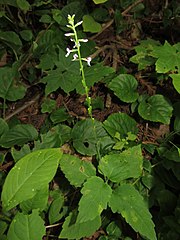
Gesneriaceae, the gesneriad family, is a family of flowering plants consisting of about 152 genera and ca. 3,540 species in the tropics and subtropics of the Old World and the New World, with a very small number extending to temperate areas. Many species have colorful and showy flowers and are cultivated as ornamental plants.
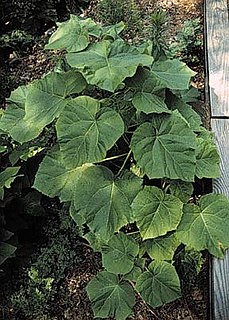
Paulowniaceae are a family of flowering plants within the Lamiales. They are a monophyletic and monogeneric family of trees with currently 7 confirmed species. They were formerly placed within Scrophulariaceae sensu lato, or as a segregate of the Bignoniaceae.

Phrymaceae, also known as the lopseed family, is a small family of flowering plants in the order Lamiales. It has a nearly cosmopolitan distribution, but is concentrated in two centers of diversity, one in Australia, the other in western North America. Members of this family occur in diverse habitats, including deserts, river banks and mountains.

Mimulus is a plant genus in the family Phrymaceae, which was traditionally placed in family Scrophulariaceae. The genus now contains only seven species, two native to eastern North America and the other five native to Asia, Australia, Africa, or Madagascar. In the past, about 150 species were placed in this genus, most of which have since been assigned to other genera, the majority to genus Erythranthe.
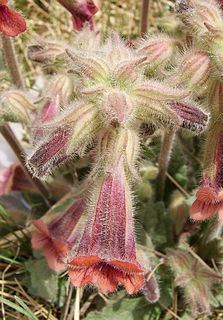
Rehmannia is a genus of seven species of flowering plants in the order Lamiales and family Orobanchaceae, endemic to China. It has been placed as the only member of the monotypic tribe Rehmannieae, but molecular phylogenetic studies suggest that it forms a clade with Triaenophora. Contrary to the immense majority of the taxa of Orobanchaceae, Rehmannia is not parasitic.
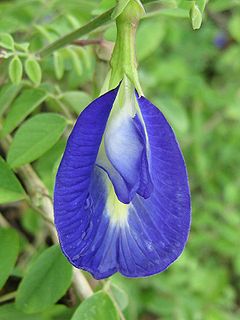
Clitoria is a genus of mainly tropical and subtropical, insect-pollinated flowering pea vines.

Phryma leptostachya, or lopseed, is a perennial herb of the genus Phryma. When distinguished from Phryma oblongifolia and Phryma nana, it is native to eastern North America.

Linnaea is a plant genus in the honeysuckle family Caprifoliaceae. Until 2013, the genus included a single species, Linnaea borealis. In 2013, on the basis of molecular phylogenetic evidence, the genus was expanded to include species formerly placed in Abelia, Diabelia, Dipelta, Kolkwitzia and Vesalea. However, this is rejected by the majority of subsequent scientific literature and flora.
Diplacus clevelandii is an uncommon species of monkeyflower known by the common name Cleveland's bush monkeyflower. It was formerly known as Mimulus clevelandii.
Erythranthe inflatula, synonyms Mimulus inflatulus and Mimulus evanescens, is a rare species of monkeyflower known by the common name disappearing monkeyflower. It is native to the western United States, where it is known from about ten locations in and around the Great Basin within the states of Idaho, Oregon, and California; it is also found in Nevada. Specimens of the plant had been catalogued as Mimulus breviflorus, but on further examination it was evident that they were a separate, unclassified species; this was described to science in 1995. It is thought that the plant may have evolved via hybridization between Erythranthe breviflora and Erythranthe latidens, or that it evolved from E. latidens and then into E. breviflora.
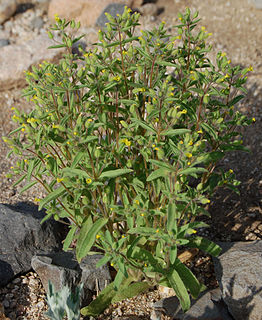
Mimetanthe is a genus of flowering plants in the family Phrymaceae. It has only one species, Mimetanthe pilosa, synonym Mimulus pilosus, known by the common names false monkeyflower and downy mimetanthe. It is native to the western United States and Baja California, where it grows in moist and disturbed habitat types. This plant is different enough from other monkeyflowers that it is treated in its own monotypic genus, Mimetanthe, or it may be retained in Mimulus.
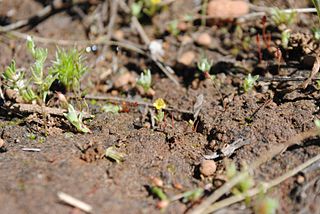
Diplacus pygmaeus is a species of monkeyflower known by the common name Egg Lake monkeyflower.

Erythranthe tilingii is a species of monkeyflower known by the common name Tiling's monkeyflower. It was formerly known as Mimulus tilingii.
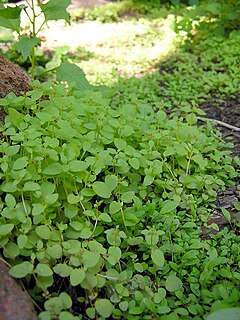
Erythranthe gemmipara is a rare species of flowering plant in the family Phrymaceae, known by the common name Rocky Mountain monkeyflower. It is endemic to Colorado in the United States, where there are eight known occurrences. It was formerly known as Mimulus gemmiparus.
Francis Whittier Pennell was an American botanist best known for his studies of the Scrophulariaceae. Employed by the New York Botanical Garden and then by the Academy of Natural Sciences of Philadelphia, he carried out botanical research in both North America and South America.

Erythranthe, the monkey-flowers and musk-flowers, is a diverse plant genus with more than 120 members in the family Phrymaceae. Erythranthe was originally described as a separate genus, then generally regarded as a section within the genus Mimulus, and recently returned to generic rank. Mimulus sect. Diplacus was segregated from Mimulus as a separate genus at the same time. Mimulus remains as a small genus of eastern North America and the Southern Hemisphere. Molecular data show Erythranthe and Diplacus to be distinct evolutionary lines that are distinct from Mimulus as strictly defined, although this nomenclature is controversial.
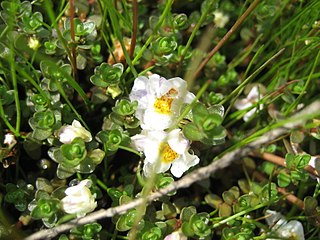
Thyridia repens, with common names creeping monkeyflower, Native musk, Maori musk, and native monkey flower, is a herbaceous succulent plant native to New Zealand and Australia that grows as low mats. Its flowers are light purple or white. It is the only species in the genus Thyridia.

Erythranthe peregrina is a species of monkeyflower. Its Latin name means "foreign", or more loosely "the foreigner". This species is a rare example of polyploidization and speciation where sterility did not occur. It was discovered in 2011, first reported in 2012, and named Mimulus peregrinus. Around the same time, the genus Mimulus was restructured and this species is now called Erythranthe peregrina and is in the section Simiolus. The species was less than 140 years old at the time of discovery in 2011; its discoverer, Mario Vallejo-Marin of the University of Stirling, compared finding it to "looking at the big bang in the first milliseconds of its occurrence".

Phryma nana is a species of flowering plant in the family Phrymaceae, native to Japan. It was first described by the Japanese botanist Gen-ichi Koidzumi in 1939. Its status as a separate species was not usually accepted, and it was treated as a subspecies or variety of Phryma leptostachya. In 2016, the distinctiveness of the Japanese P. nana was again supported, based on both earlier molecular phylogenetic analysis and morphological analysis. As of April 2022, the species is recognized by Plants of the World Online.
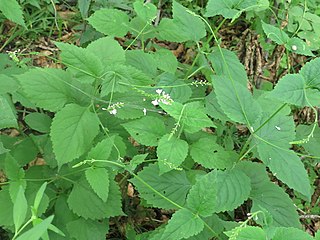
Phryma oblongifolia is a species of flowering plant in the family Phrymaceae, native from temperate Asia southwards to the Himalayas and north Vietnam. It was first described by Gen-ichi Koidzumi in 1929. Its status as a separate species was not usually accepted, and it was treated as a variety of Phryma leptostachya. In 2014, the distinctiveness of North American P. leptostachya and Asian P. oblongifolia was supported, based on morphological evidence and a previous molecular phylogenetic study. As of April 2022, the species is recognized by Plants of the World Online.


